Chip-4Dopamine

Sub-9×29 µm², 1.2 nW, Fully Digital Potentiostat for Dopamine Sensing
Application
This chip enables real-time detection of dopamine (DA), a key neuromodulatory molecule involved in brain functions such as movement, reward, and mood regulation. It is designed for ultra-miniaturized, wirelessly powered implants like Neural Dust and Body Dust, where both size and power consumption are critical constraints.
Short Description
Chip-4Dopamine is the smallest and lowest-power potentiostat ever fabricated for electrochemical sensing. It integrates a fully digital potentiostat within only 260 µm², consuming 1.2 nW at 0.4 V supply. The system, fabricated in TSMC 180nm CMOS, supports chronoamperometric detection of dopamine using a three-electrode electrochemical cell. Unlike traditional analog designs, this chip merges sensing, digitization, and control into a single, digital block based on a digital OTA architecture.
Key Features
· Total area: 370 µm² (including reference and oscillator)
· Total power: 9.2 nW
· Operating voltage: 0.4–0.56 V
· Sampling window: 100 ms, dynamic range: 60 dB
· Fabrication: TSMC 180nm CMOS
· Ideal for ultra-miniaturized neural implants
Design Team
Ali Meimandi (PhD candidate) with the assistance of Dr. Gian Luca Barbruni and supervision of Prof. Sandro Carrara, external page Bio/CMOS Interfaces Lab, EPFL.
Publications
A. Meimandi, Barbruni, G. L., & Carrara, S. (2025). A More Reliable Equivalent Circuit of Electrochemical Sensors for Robust Design of CMOS Front-ends. external page IEEE Sensors Journal. DOI: 10.1109/JSEN.2025.3554450 [external page Paper: IEEE Xplore]
A. Meimandi, G. L. Barbruni, P. S. Crovetti, and S. Carrara, “Sub9×29 µm2, 1.2nw, fully digital potentiostat design for dopamine sensing,” submitted to IEEE Sensors Journal.
